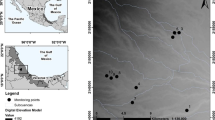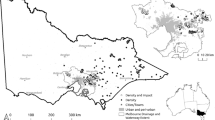Abstract
We investigated the effects of short- and long-term ungulate grazing on plant species cover and composition in arid lowland and more mesic upland communities of the Pryor Mountain Wild Horse Range (PMWHR). Measurements were taken over two years which differed significantly in growing season precipitation. Interannual differences in plant cover were significantly greater than differences between grazed and ungrazed communities. In the arid lowlands total plant cover decreased from 47% in 1993, a relatively wet year, to 29% in 1994, a relatively dry year. In the more mesic uplands total plant cover decreased from 107% in 1993 to 56% in 1994. The magnitude of change in cover was greatest in the grasses, especially for Pseudoroegneria spicata, the most abundant species in the lowland communities, which decreased from 21% cover in 1993 to 11% in 1994. There was not a consistent effect of herbivory on plant cover across sites, but its effects, particularly on the dominant perennial grasses, were conspicuous at some sites. For instance, in the lowlands cover of P. spicata was 3–12% in long-term grazed sites and 9–28% in short- to long-term ungrazed sites. Our study indicates that abiotic factors (e.g., precipitation) are more likely than grazing to affect abundances of key plant species, and hence ecosystem dynamics, in the PMWHR, and that the effects of herbivory are more localized and more prevalent in the lowland grasses than in the other plant functional groups.
Similar content being viewed by others
References
Archer, S. & Detling, J. K. 1984. The effects of defoliation and competition on regrowth of tillers of two North American mixedgrass prairie graminoids. Oikos 43: 351-357.
Austin, M. P., Williams, O. B. & Belbin, L. 1981. Grassland dynamics under sheep grazing in Australian Mediterranean type climate. Vegetatio 47: 201-211.
Bastian, C. T., Van Tassell, L. W., Cotton, A. C. & Smith, M. A. 1999. Opportunity costs related to feral horses: a Wyoming case study. J. Range Manage. 52: 104-112.
Belsky, A. J. 1987. The effects of grazing: confounding of ecosystem, community, and organism scales. Am. Nat. 129: 777-783.
Berger, J. 1986. Wild horses of the Great Basin. University of Chicago Press, Chicago.
BLM. 1984. Herd management area plan: Pryor Mountain Wild Horse Range. U.S. Department of the Interior.
Boyce, M. S., Metzgar, L. H. & Peters, J. T. 1990. Bighorn sheep and horses on the Bighorn Canyon National Recreation Area: wilderness or pasture? Pp. 51-67. In: Zeveloff, S. I. & McKell, C. M. (eds),Wilderness issues in arid lands of the western United States. University of New Mexico Press, Albuquerque.
Burke, I. C., Kittel, T. G. F., Lauenroth, W.K., Snook, P., Yonker, C. M. & Parton, W. J. 1991. Regional analysis of the central Great Plains. BioScience 41: 685-692.
Chapin, F. S., III & McNaughton, S. J. 1989. Lack of compensatory growth under phosphorus deficiency in grazing-adapted grasses from the Serengeti plains. Oecologia 79: 551-557.
Coates, K. P. & Schemnitz, S. D. 1988. Habitat utilization, interspecific interactions and status of a recolonized population of bighorn sheep at a wild horse range. Completion report to the University ofWyoming - National Park Service Research Center and Bighorn Canyon National Recreation Area.
Coates, K. P. & Schemnitz, S. D. 1989. The bighorn sheep of Bighorn Canyon National Recreation Area and Pryor Mountain Wild Horse Range: ecological relationships and management recommendations. Completion report to the National Park Service and the Bureau of Land Management.
Collins, S. L., Knapp, A. K., Briggs, J. M., Blair, J. M. & Steinauer, E. M. 1998. Modulation of diversity by grazing and mowing in native tallgrass prairie. Science 280: 745-747.
Coppock, D. L., Detling, J. K., Ellis, J. E. & Dyer, M. I. 1983. Plantherbivore interactions in a North American mixed-grass prairie. I. Effects of black-tailed prairie dogs on intraseasonal aboveground plant biomass and nutrient dynamics and plant species diversity. Oecologia 56: 1-9.
Coughenour, M. B. 1985. Graminoid responses to grazing by large herbivores: adaptations, exaptations, and interacting processes. Ann. Missouri Bot. Gard. 72: 852-863.
Coupland, R. T. 1958. The effects of fluctuations in weather upon the grasslands of the Great Plains. Bot. Rev. 24: 273-317.
Crawley, M. J. 1983. Herbivory: the dynamics of animal-plant interactions. University of California Press, Berkeley.
Cumming, D. H. M. 1982. The influence of large herbivores in savanna structure in Africa. Pp. 217-245. In: Huntley, B. J. & Walker, B. H. (eds), Ecology of tropical savannas. Springer-Verlag, Berlin.
Daubenmire, R. 1959. A canopy-coverage method of vegetational analysis. Northwest Sci. 33: 43-64.
Detling, J. K. 1987. Grass response to herbivory. Pp. 56-68. In: Capinera, J. L. (ed), Integrated pest management on rangeland: a shortgrass prairie perspective. Westview Press, Boulder.
Fahnestock, J. T. 1998. Vegetation responses to herbivory and resource supplementation in the Pryor Mountain Wild Horse Range. PhD Dissertation. Colorado State University, Fort Collins.
Fahnestock, J. T. & Detling, J. K. 1999. Plant responses to defoliation and resource supplementation in the Pryor Mountains. J. Range Manage. 52: 263-270.
Fahnestock, J. T. & Knapp, A. K. 1994. Plant responses to selective grazing by bison: interactions between light, herbivory and water stress. Vegetatio 115: 123-131.
Fisher, C. 1983. The wild horse dilemma: background, prospective, and action. Rangelands 5: 164-166.
Fisser, H. G. 1964. Range survey in Wyoming's Big Horn Basin. Wyoming Ag. Exp. Stat. Bull. 424R.
Frank, D. A. & McNaughton, S. J. 1991. Stability increases with diversity in plant communities: empirical evidence from the 1988 Yellowstone drought. Oikos 62: 360-362.
Hansen, R.M. & Gold, I. K. 1977. Blacktail prairie dogs, desert cottontails and cattle trophic relations on shortgrass range. J. Range Manage. 30: 210-213.
Hartnett, D. C., Hickman, K. R. & Fischer Walter, L. E. 1996. Effects of bison grazing, fire, and topography on floristic diversity in the tallgrass prairie. J. Range Manage. 49: 413-420.
Heady, H. F. 1966. Influence of grazing on composition of Themeda triandra grassland, east Africa. J. Ecol. 54: 705-728.
Hutcheson, K. 1970. A test for comparing diversities based on the Shannon formula. J. Theor. Biol. 29: 151-154.
Jameson, D. A. 1963. Responses of individual plants to harvesting. Bot. Rev. 29: 532-594.
Kartesz, J. T. 1994. A synonymized checklist of the vascular flora of the United States, Canada, and Greenland. Timber Press, Portland.
Kissell, R. J., Jr. 1996. Competitive interactions among bighorn sheep, feral horses, and mule deer in Bighorn Canyon National Recreation Area and the Pryor Mountain Wild Horse Range. PhD Dissertation. Montana State University, Bozeman.
Knapp, A. K. 1984. Water relations and growth of three grasses during wet and drought years in a tallgrass prairie. Oecologia 65: 35-43.
Knight, D. H., Jones, G. P., Akashi, Y. & Myers, R. W. 1987. Vegetation ecology in the Bighorn Canyon National Recreation Area. A final report submitted to the U.S. National Park Service and the University of Wyoming - National Park Service Research Center.
Lauenroth, W. K. 1979. Grassland primary production: North American grasslands in perspective. Pp. 3-24. In: French, N. R. (ed), Perspectives in grassland ecology. Springer-Verlag, New York.
Lauenroth, W. K. & Sala, O. E. 1992. Long-term forage production of North American shortgrass steppe. Ecol. Appl. 2: 397-403.
Lichvar, R. W., Collins, E. I. & Knight, D. H. 1985. Checklist of vascular plants for the Bighorn Canyon National Recreation Area, Wyoming and Montana. Great Basin Nat. 45: 734-746.
Mack, R. N. & Thompson, J. N. 1982. Evolution in steppe with few large, hooved mammals. Am. Nat. 119: 757-773.
McNaughton, S. J. 1979. Grassland-herbivore dynamics. Pp. 46-81. In: Sinclair, A. R. E. & Norton-Griffiths, M. (eds), Serengeti, dynamics of an ecosystem. University of Chicago Press, Chicago.
McNaughton, S. J. 1985. Ecology of a grazing ecosystem: the Serengeti. Ecol. Mono. 55: 259-294.
McNaughton, S. J. 1986. On plants and herbivores. Am. Nat. 128: 765-770.
McNaughton, S. J., Coughenour, M. B. & Wallace, L. L. 1982. Interactive processes in grassland ecosystems. Pp. 167-193. In: Estes, J.R., Tyrl, E. R. & Brunken, J. N. (eds), Grasses and grasslands. University of Oklahoma Press, Norman.
McNaughton, S. J., Ruess, R.W. & Seagle, S.W. 1988. Large mammals and process dynamics in African ecosystems. BioScience 38: 794-800.
Milchunas, D. G. & Lauenroth, W. K. 1993. Quantitative effects of grazing on vegetation and soils over a global range of environments. Ecol. Mono. 63: 327-366.
Milchunas, D. G., Sala, O. E. & Lauenroth, W. K. 1988. A generalized model of the effects of grazing by large herbivores on grassland community structure. Am. Nat. 132: 87-106.
Milchunas, D. G., Lauenroth, W. K., Chapman, P. L. & Kazempour, M. K. 1989. Effects of grazing, topography, and precipitation on the structure of a semiarid grassland. Vegetatio 80: 11-23.
Milchunas, D. G., Forwood, J. R. & Lauenroth, W. K. 1994. Forage production across fifty years of grazing intensity treatments in the shortgrass steppe. J. Range Manage. 47: 133-139.
Noy-Meir. I., Gutman, M. & Kaplan, Y. 1989. Responses of Mediterranean grassland plants to grazing and protection. J. Ecol. 77: 290-310.
O'Connor, T. G. & Roux, P. W. 1995. Vegetation changes (1949- 71) in a semi-arid, grassy dwarf shrubland in the Karoo, South Africa: influence of rainfall variability and grazing by sheep. J. Appl. Ecol. 32: 612-626.
Olff, M. & Ritchie, M. E. 1998. Effects of herbivores on grassland plant diversity. Trends Ecol. Evol. 13: 261-265.
Peterson, J., Fahnestock, J. & Detling, J. K. 1997. Ungulate/ vegetation interactions at the Pryor Mountain Wild Horse Range. Completion report to the National Park Service and the Bureau of Land Management.
Ripley, E. A. 1979. Grassland climate. Pp. 7-24. In: Coupland, R. T. (ed), Grassland ecosystems of the world. Cambridge University Press, Cambridge.
Sala, O. E. 1988. The effect of herbivory on vegetation structure. Pp. 317-330. In: Werger, M. J. A., van der Aart, P. J. M, During, H. J. & Verhoeven, J. T. A. (eds), Plant form and vegetation structure. SPB Academic Publishing, The Hague.
SAS Institute. 1989. SAS/STAT User's Guide, Fourth Edition. SAS Institute Inc., Cary.
Seastedt, T. R. 1985. Maximization of primary and secondary productivity by grazers. Am. Nat. 126: 559-564.
Stebbins, G. L. 1981. Coevolution of grasses and herbivores. Ann. Missouri Bot. Gard. 68: 75-86.
Stohlgren, T. J., Bull, K. A. & Otsuki, Y. 1998. Comparison of rangeland vegetation sampling techniques in the Central Grasslands. J. Range Manage. 51: 164-172.
Tilman, D. & Downing, J. A. 1994. Biodiversity and stability in grasslands. Nature 367: 363-365.
Tilman, D., Wedin, D. & Knops, J. 1996. Productivity and sustainability influenced by biodiversity in grassland ecosystems. Nature 379: 718-720.
Wallace, L. L., McNaughton, S. J. & Coughenour, M. B. 1984. Compensatory photosynthetic responses of three African graminoids to different fertilization, watering and clipping regimes. Bot. Gaz. 145: 151-156.
Webb, W., Szarek, S., Lauenroth, W., Kinerson, R. & Smith, M. 1978. Primary productivity and water use in native forest, grassland, and desert ecosystems. Ecology 59: 1239-1247.
Webb, W. L., Lauenroth, W. K., Szarek, S. R. & Kinerson, R. S. 1983. Primary production and abiotic controls in forests, grasslands, and desert ecosystems in the United States. Ecology 64: 134-151.
Whicker, A. D. & Detling, J.K. 1988. Modification of vegetation structure and ecosystem processes by North American grassland mammals. Pp. 301-316. In: Werger, M. J. A., van der Aart, P. J. M., During, H. J. & Verhoeven, J. T. A. (eds), Plant form and vegetation structure. SPB Academic Publishing, The Hague.
Williams, C. S. 1963. Ecology of bluebunch wheatgrass in northwestern Wyoming. PhD Dissertation. University of Wyoming, Laramie.
Zar, J. H. 1984. Biostatistical analysis, Second Edition. Prentice Hall, Englewood Cliffs.
Author information
Authors and Affiliations
Rights and permissions
About this article
Cite this article
Fahnestock, J.T., Detling, J.K. The influence of herbivory on plant cover and species composition in the Pryor Mountain Wild Horse Range, USA. Plant Ecology 144, 145–157 (1999). https://doi.org/10.1023/A:1009899509067
Issue Date:
DOI: https://doi.org/10.1023/A:1009899509067




